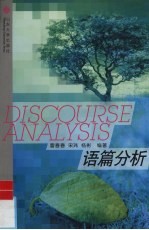图书介绍
语篇分析 英文pdf电子书版本下载

- 曹春春等编著 著
- 出版社: 济南:山东大学出版社
- ISBN:7560726836
- 出版时间:2003
- 标注页数:300页
- 文件大小:8MB
- 文件页数:316页
- 主题词:英语-语言分析
PDF下载
下载说明
语篇分析 英文PDF格式电子书版下载
下载的文件为RAR压缩包。需要使用解压软件进行解压得到PDF格式图书。建议使用BT下载工具Free Download Manager进行下载,简称FDM(免费,没有广告,支持多平台)。本站资源全部打包为BT种子。所以需要使用专业的BT下载软件进行下载。如 BitComet qBittorrent uTorrent等BT下载工具。迅雷目前由于本站不是热门资源。不推荐使用!后期资源热门了。安装了迅雷也可以迅雷进行下载!
(文件页数 要大于 标注页数,上中下等多册电子书除外)
注意:本站所有压缩包均有解压码: 点击下载压缩包解压工具
图书目录
1 Introduction 1
1.1 What is discourse analysis? 1
1.1.1 What is discourse? 1
1.1.2 What is discourse analysis? 5
1.1.3 A brief historical overview 7
1.2 Form and function 12
1.2.1 What is language for? 12
1.2.2 Macro-functions 16
1.2.3 Form and function 20
2 Genre Analysis and Discourse Structure 24
2.1 Genre analysis and discourse type 24
2.1.1 What is genre? 24
2.1.2 What is register? 28
2.1.3 Various discourse types 30
2.2 Discourse type recognition 34
2.3 Conversation as a discourse type 36
2 4 Discourse type and communicative functions 41
2.4.1 Type and function 41
2.4.2 Discourse part 45
2.5 Genre and discourse patterns 51
2.5.1 The problem-solution pattern 52
2.5.2 The general-particular pattern 53
2.5.3 The hypothetical-real pattern 54
2.5.4 The matching pattern 57
3 Speech Act Theory 61
3.1 Performatives and constatives 61
3 2 Explicit and implicit performatives 63
3.3 Illocutionary act 65
3.4 Classification of speech acts 68
3.5 Conditions for illocutionary acts 72
3.5.1 Essential conditions 73
3.5.2 Propositional content conditions 73
3.5.3 Preparatory conditions 74
3.5.4 Sincerity conditions 74
3.6 Indirect speech act theory 75
3.6.1 Searle's indirect speech act theory 75
3.6.2 Conventional indirect speech acts 77
3.6.3 Non-conventional indirect speech acts 79
3.7 Speech acts and discourse 82
4 Conversational Implicature and Conversational Principles 88
4.1 What is an implicature? 88
4.2 Conversational implicature and cooperative principle 90
4.2.1 Conversational implicature 90
4.2.2 Cooperative principle 91
4.3 Non-observance of the conversational maxims 94
4.3.1 Violating a maxim 94
4.3.2 Opting out of a maxim 95
4.3.3 Infringing a maxim 96
4.3.4 Suspending a maxim 96
4.3.5 Flouting a maxim 97
4.4 Characteristics of implicature 102
4.4.1 Cancellability 102
4.4.2 Non-detachability 103
4.4.3 Calculability 103
4.4.4 Non-conventionality 104
4.5 Politeness principle 105
4.5.1 Politeness principle 105
4.5.2 Lakoff's maxims of politeness 105
4.5.3 Leech's maxims of politeness 106
4.5.4 Face theory 109
4.5.5 Politeness in Chinese context 111
4.6 Relevance Theory 115
4.6.1 Ostensive-inferential communication 115
4.6.2 Relevance of an input to an individual 116
4.6.3 Cognitive principle of relevance 118
4.6.4 Communicative principle of relevance 119
4.6.5 Optimal relevance 120
5 Spoken Discourse and Discourse Analysis 122
5.1 Conversations in school classrooms 122
5.1.1 The Sinclair-Coulthard'Birmingham'model 122
5.1.2 Exchange,move and internal structure 128
5.1.3 Exchanges and discourse functions 130
5.1.4 The follow-up move of classroom conversations 136
5.1.5 Spoken language in the classroom 138
5.2 Conversations outside the classroom&( 140
5.3 Transactions and topics 144
5.3.1 Transactions 144
5.3.2 Topics 145
5.4 Narrative:a human universal 149
5.4.1 Sociolinguistic studies of narrative 150
5.4.2 Psycholinguistic studies of narrative 155
5.4.3 Discourse studies of narrative 156
6 Conversation Analysis 160
6.1 Turn-taking 161
6.2 Adjacency pairs 165
6.3 Insertion sequences and side sequences 168
6.4 Preference organization 171
6.5 Pre-sequences 176
6.6 Concluding remarks 179
7 Cohesion and Coherence 185
7.1 What is cohesion? 185
7.2 Cohesive devices 186
7.2.1 Reference 187
7.2.2 Substitution 192
7.2.3 Ellipsis 194
7.2.4 Conjunction 195
7.3 What is coherence? 198
7.4 Theories of coherence 206
7.5 Conclusion 210
8 Discourse Analysis and Vocabulary 213
8.1 Lexical cohesion 213
8.1.1 Reiteration 214
8.1.2 Collocation 217
8.2 Lexis in conversation 224
8.3 Vocabulary and the organizing of text 228
9 Theme and Rheme 235
9.1 What is theme? 235
9 2 Types of themes 238
9.3 Marked theme 244
9.4 lnformation structure 246
9.4.1 'Staging' 247
9.4.2 Given and new 248
9.5 Text structure 254
10 Schema 263
10.1 What is schema? 263
10.2 Classifications of schema 266
10.2.1 Frame and script 266
10.2.2 Content schema and formal schema 269
10.3 Rhetorical genre analysis 270
10.4 Implications for discourse comprehension 274
10.5 Schema theory and literature 282
10.5.1 Literariness 282
10.5.2 Schema reinforcing and schema refreshment 284
10.6 Conclusion 287
Bibliography 290